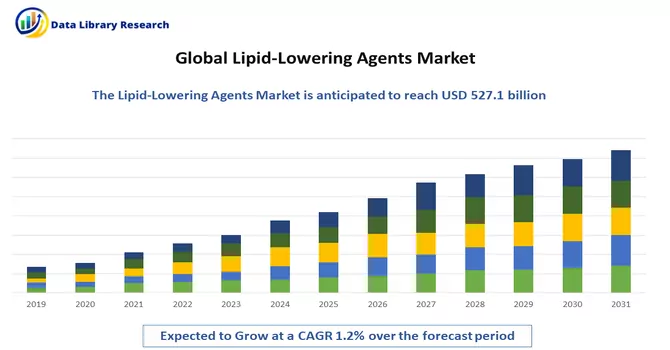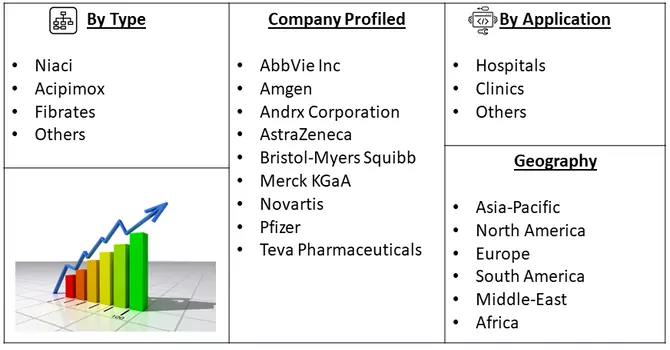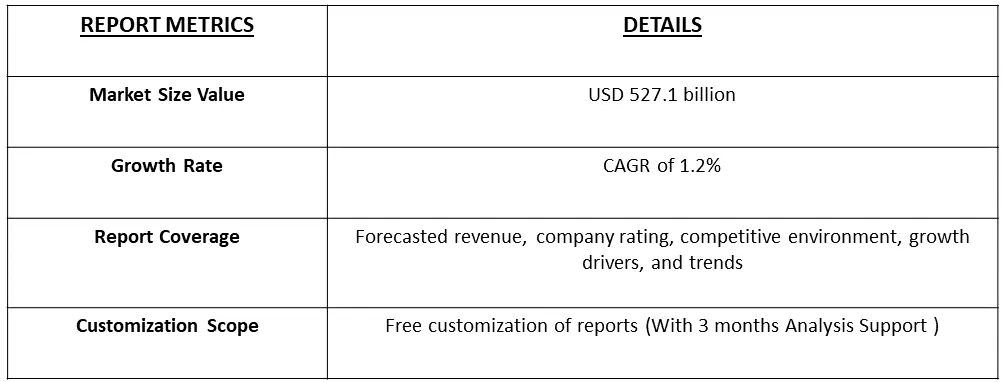The current valuation of the Lipid-Lowering Agents market stands at USD 527.1 billion, and projections indicate a moderate growth of 1.2% over the forecast period spanning from 2023 to 2030.

Get Complete Analysis Of The Report - Download Free Sample PDF
The Lipid-Lowering Agents market comprises a diverse range of pharmaceutical products, encompassing statins, fibrates, bile acid sequestrants, PCSK9 inhibitors, and newer drug classes like PCSK9 inhibitors. These medications are designed to regulate lipid levels within the body. Their mechanisms involve either reducing cholesterol production in the liver or enhancing the removal of cholesterol from the bloodstream. Lipid regulators are commonly prescribed to individuals at risk of lipid-related disorders or those already diagnosed, aiming to manage and control their lipid profiles. This, in turn, helps in reducing the risk of cardiovascular events and other associated complications. Elevated cholesterol levels significantly contribute to the risk of cardiovascular diseases (CVDs), which remain a leading cause of mortality globally. The escalating prevalence of CVDs, coupled with an enhanced understanding of the role of lipids in these conditions, propels the demand for effective lipid-lowering medications. Increased awareness among both individuals and healthcare professionals regarding the impact of elevated lipid levels on heart health plays a pivotal role in fostering the demand for lipid regulators. This awareness is further heightened through education campaigns, health screenings, and initiatives that promote healthy lifestyles.
The comprehensive approach towards managing lipid levels reflects the evolving landscape of preventive healthcare, with lipid-lowering agents playing a crucial role in reducing the burden of cardiovascular diseases. As awareness continues to grow and healthcare initiatives gain momentum, the Lipid-Lowering Agents market is poised for gradual yet steady expansion over the forecast period.
This emerging class of medications has garnered attention due to its robust capability to significantly lower LDL cholesterol levels. Continuous research and development efforts are directed towards enhancing the effectiveness and accessibility of these drugs. Innovations in RNA-based therapies, such as RNA interference (RNAi) drugs that target specific genes involved in lipid metabolism, hold promise for achieving precise and effective lipid regulation.
Pharmaceutical companies are actively exploring fixed-dose combinations of various lipid-lowering agents to provide both convenience and heightened efficacy to patients. By combining drugs with distinct mechanisms of action, a synergistic effect can be achieved, leading to improved control over lipid levels. This approach reflects the industry's commitment to innovation and addressing the multifaceted nature of lipid-related disorders.
Moreover, there is a growing trend among healthcare providers to adopt polypharmacy approaches, wherein lipid regulators are combined with medications targeting other risk factors such as hypertension or diabetes. This comprehensive strategy aims for a more holistic approach to cardiovascular risk management. By addressing multiple risk factors simultaneously, healthcare professionals strive to enhance overall patient outcomes and reduce the likelihood of cardiovascular events. The evolving landscape of lipid-lowering medications, marked by innovative therapies and combination strategies, underscores the commitment to advancing cardiovascular health and underscores the potential for more effective and personalized treatment options in the future.
Market Segmentation: The Lipid Regulators Market is segmented by Type (Statins (Branded statins, Statin combinations, and Generic statins), and Non-statins (Fibric-acid derivatives, Bile-acid Sequestrants, Nicotinic Acid Derivatives, and Other New Products)), and Geography (North America, Europe, Asia-Pacific, Middle East, and Africa, and South America). The report offers the value (in USD million) for the above segments.

For Detailed Market Segmentation - Download Free Sample PDF
Market Drivers:
Increasing Cardiovascular Disease Prevalence and Awareness:
The global incidence of cardiovascular diseases, encompassing conditions such as atherosclerosis and coronary artery disease, is on a continuous upward trajectory. Elevated levels of lipids, particularly cholesterol, play a significant role in the development of these conditions. As awareness about the correlation between high lipid levels and heart-related ailments expands, there is a heightened demand for effective lipid-lowering medications. Global initiatives, including awareness campaigns, health education programs, and efforts by healthcare organizations and governments, are increasingly emphasizing the crucial role of managing lipid levels to mitigate the risk of cardiovascular diseases. Major drivers for the growing demand in the market include the escalating prevalence of diabetes, cardiac diseases, and the expanding geriatric population. According to the 2022 American Heart Association (AHA) report, approximately 244.1 million people worldwide were living with ischemic heart disease (IHD). Regions such as North Africa, the Middle East, Central and South Asia, and Eastern Europe reported the highest prevalence rates of IHD in 2021. This burden of cardiovascular diseases is anticipated to surge further due to the high prevalence of associated risk factors, including hypertension, obesity, smoking, diabetes, and sedentary lifestyles.
Lipids play a pivotal role as vital biomolecules in metabolic functions, and the use of lipid-altering medications has demonstrated efficacy in reducing cardiovascular risk. This increased awareness is prompting individuals to seek medical interventions, thereby fueling the demand for lipid regulators in the market. The collective efforts of healthcare organizations, governments, and awareness campaigns are instrumental in shaping a proactive approach toward managing lipid levels, ultimately contributing to the growth of the lipid regulators market.
Technological Advancements and Drug Innovations:
The continuous research and development initiatives within the pharmaceutical industry are yielding new discoveries and the development of lipid-regulating drugs characterized by enhanced efficacy, fewer side effects, and innovative mechanisms of action. These advancements broaden the array of options accessible to healthcare providers and patients, thereby fostering notable growth in the market. Progress in comprehending genetics and the implementation of personalized medicine approaches contribute to the emergence of more precisely targeted lipid-lowering treatments.
The integration of personalized medicine involves tailoring medications based on specific genetic markers or individual patient profiles. This tailored approach significantly improves treatment effectiveness and enhances overall patient outcomes. The evolving landscape of lipid regulators in clinical practice is witnessing the adoption of newer medications that leverage these personalized strategies. As our understanding of genetics deepens and technologies enable more precise interventions, the pharmaceutical industry is poised to offer increasingly tailored and effective lipid-lowering drugs, ultimately transforming the landscape of cardiovascular care.
Market Restraints:
Side Effects and Safety Concerns and Competition and Patent Expirations:
Certain lipid-lowering medications, notably statins, have been associated with side effects such as muscle pain, liver damage, and gastrointestinal issues in a subset of patients. These adverse reactions may result in non-compliance or the discontinuation of treatment, significantly affecting patient adherence. Concerns regarding the long-term safety of specific lipid regulators, particularly when used over extended periods, create reservations among both patients and healthcare providers, potentially constraining widespread adoption. The introduction of generic versions of established lipid-lowering drugs, following patent expiration, frequently triggers price reductions and heightened competition. This dynamic impacts the market share and profitability of branded medications. The competitive landscape, influenced by the availability of generic alternatives, can exert pressure on the pricing strategies of lipid regulators, consequently influencing revenue margins for pharmaceutical companies. This scenario underscores the delicate balance between ensuring medication affordability and maintaining the financial viability of innovative pharmaceutical solutions in the lipid-regulating market. Thus, such factors are expected to contribute towatds the studied market’s growth.
At the peak of the pandemic, healthcare resources were primarily redirected toward managing COVID-19 patients, resulting in a diminished focus on routine and non-emergency care. Many individuals opted to postpone or avoid regular medical check-ups, including crucial lipid profile assessments, thereby affecting the diagnosis and treatment of lipid disorders. Lockdowns, restrictions, and concerns about virus exposure contributed to reduced access to healthcare facilities, impacting patient consultations, diagnostic tests, and medication adherence for those with lipid disorders. This shift in healthcare priorities during the pandemic has the potential to influence the lipid regulator market. Interestingly, the pandemic saw an increased demand for lipid-based supplements due to their recognized health benefits. A notable example is highlighted in an NCBI study published in October 2021, which revealed that COVID-19 infection can influence the lipid profile, leading to dyslipidemia that may require appropriate treatment. Statin therapy, with its antiviral, anti-inflammatory, immunomodulatory, and cardioprotective properties, emerged as a valuable tool for improving COVID-19 outcomes. Consequently, the consumption of lipid nutritional products witnessed a surge during the pandemic, positively impacting the market.
The upward trend in the market is anticipated to persist over the forecast period, driven by the increased incidence of cardiovascular diseases resulting from the aftermath of the pandemic. The recognition of the interplay between lipid disorders and overall health, especially in the context of COVID-19, is likely to contribute to the sustained growth of the lipid regulator market.
Segmentation Analysis:
Statins Segment is Expected to Witness Significant Growth Over the Forecast Period
Statins stand out as highly effective agents in the reduction of LDL cholesterol, commonly known as "bad" cholesterol. Their mechanism of action involves the inhibition of an enzyme crucial in cholesterol production within the liver, leading to a decrease in the amount of circulating cholesterol in the bloodstream. This demonstrated efficacy in lowering LDL cholesterol levels has positioned statins as a cornerstone in lipid-lowering therapies, particularly for individuals at an elevated risk of cardiovascular diseases.
The growth of the statins segment is anticipated to be fueled by the increasing diabetic population. Individuals with diabetes are more prone to a higher incidence of dyslipidemia, making statins a crucial component in managing lipid profiles. According to the World Health Organization, the global diabetic population exceeds 400.0 million, with diabetes treatment constituting approximately 12.0% of the total healthcare expenditure globally. The prevalence of diabetes has evolved into a global epidemic, affecting millions across the world, with around 10% of cases being type 1 diabetes and the majority being type 2 diabetes.
Thus, of dyslipidemia management, statins competitively inhibit HMG-CoA reductase, offering a potent means to lower lipid levels in populations with underlying cardiovascular risk factors, including diabetes. As the prevalence of diabetes continues to rise, the role of statins in addressing dyslipidemia within diabetic populations becomes increasingly significant. The statins segment is poised to experience growth in tandem with the expanding diabetic demographic, solidifying its position as a key player in lipid-lowering therapies.
North America Region is Expected to Witness Significant Growth Over the Forecast Period
North America, with a particular emphasis on the United States and Canada, grapples with a significant prevalence of cardiovascular diseases (CVDs), with high cholesterol levels emerging as a primary risk factor. This scenario has led to a considerable demand for lipid-lowering medications aimed at managing cholesterol levels and mitigating cardiovascular risks. Several factors contribute to the growth of the lipid regulators market in this region, including noteworthy product launches, a concentrated presence of market players, strategic acquisitions, and partnerships among major industry stakeholders.
One of the driving forces behind the market's expansion in the United States is the alarming rise in obesity cases. According to recent CDC data as of May 2022, over 41.9% of Americans were classified as obese, marking a notable increase from 30.5% during a comparable period. Additionally, severe obesity surged from 4.7% to 9.2% within the same timeframe. Recognizing obesity as a leading cause of preventable death in the United States, the CDC emphasizes its role as a significant contributor to chronic diseases globally and within the country. Obesity-related comorbidities, notably cardiovascular diseases and certain cancers, further underscore the urgent need for cholesterol control. The growing prevalence of obesity underscores the critical role of lipid regulators in managing cholesterol levels, thus bolstering the market's growth trajectory in the United States. Against the backdrop of these health challenges and the imperative for effective lipid-lowering interventions, the lipid regulators market is expected to experience sustained growth over the forecast period in the United States.

Get Complete Analysis Of The Report - Download Free Sample PDF
The lipid regulators market exhibits a high degree of competitiveness and fragmentation, with a significant portion of the market being dominated by global key players. These industry leaders, possessing substantial resources for research and well-established distribution systems, have solidified their positions within the market. The competitive landscape is characterized by a dynamic interplay among these influential players, each vying for a larger share of the lipid regulator market. The market's competitive nature is driven by factors such as ongoing research and development initiatives, strategic investments, and the ability to efficiently distribute products across diverse geographical regions. Companies with robust financial capacities and a strong global presence are better equipped to navigate the complexities of the lipid regulators market. As a result, they often enjoy a competitive advantage, allowing them to shape market trends, introduce innovations, and maintain a prominent market position.
Some Market Players :
Recent Developments:
1) In May 2022, Sun Pharmaceutical Industries Limited launched a first-in-class oral drug, Bempedoic Acid, in India for reducing low-density lipoprotein (LDL) cholesterol. The company launched the drug under the brand name Brillo.
2) In March 2022, Evonik announced the development of a cGMP facility in Hanau, Germany, to manufacture lipids for clinical development and the launch of innovative medicines.
Q1. What is the current Lipid-Lowering Agents Market size?
The current valuation of the Lipid-Lowering Agents market stands at USD 527.1 billion.
Q2. What is the Growth Rate of the Lipid-Lowering Agents market?
Lipid-Lowering Agents market is expecting a moderate growth of 1.2% over the forecast period.
Q3. What are the factors driving the Lipid-Lowering Agents market?
Key factors that are driving the growth include the Increasing Cardiovascular Disease Prevalence and Awareness and Technological Advancements and Drug Innovations.
Q4. Which region has the largest share of the Lipid-Lowering Agents market? What are the largest region's market size and growth rate?
North America has the largest share of the market. For detailed insights on the largest region's market size and growth rate request a sample here.
Data Library Research are conducted by industry experts who offer insight on industry structure, market segmentations technology assessment and competitive landscape (CL), and penetration, as well as on emerging trends. Their analysis is based on primary interviews (~ 80%) and secondary research (~ 20%) as well as years of professional expertise in their respective industries. Adding to this, by analysing historical trends and current market positions, our analysts predict where the market will be headed for the next five years. Furthermore, the varying trends of segment & categories geographically presented are also studied and the estimated based on the primary & secondary research.
In this particular report from the supply side Data Library Research has conducted primary surveys (interviews) with the key level executives (VP, CEO’s, Marketing Director, Business Development Manager and SOFT) of the companies that active & prominent as well as the midsized organization
FIGURE 1: DLR RESEARH PROCESS

Extensive primary research was conducted to gain a deeper insight of the market and industry performance. The analysis is based on both primary and secondary research as well as years of professional expertise in the respective industries.
In addition to analysing current and historical trends, our analysts predict where the market is headed over the next five years.
It varies by segment for these categories geographically presented in the list of market tables. Speaking about this particular report we have conducted primary surveys (interviews) with the key level executives (VP, CEO’s, Marketing Director, Business Development Manager and many more) of the major players active in the market.
Secondary ResearchSecondary research was mainly used to collect and identify information useful for the extensive, technical, market-oriented, and Friend’s study of the Global Extra Neutral Alcohol. It was also used to obtain key information about major players, market classification and segmentation according to the industry trends, geographical markets, and developments related to the market and technology perspectives. For this study, analysts have gathered information from various credible sources, such as annual reports, sec filings, journals, white papers, SOFT presentations, and company web sites.
Market Size EstimationBoth, top-down and bottom-up approaches were used to estimate and validate the size of the Global market and to estimate the size of various other dependent submarkets in the overall Extra Neutral Alcohol. The key players in the market were identified through secondary research and their market contributions in the respective geographies were determined through primary and secondary research.
Forecast Model
